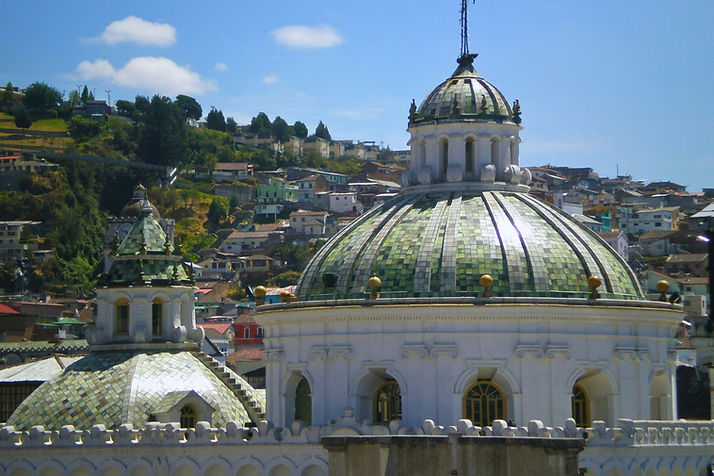
Quito, the capital city of Ecuador, is a stunning destination known for its rich history, vibrant culture, and breathtaking landscapes. Located high in the Andes Mountains, Quito boasts a beautifully preserved historic centre, a UNESCO World Heritage site. Visitors can explore the iconic Plaza Grande, the impressive Basilica del Voto Nacional, and the vibrant La Ronda district. With its mild climate, friendly locals, and diverse attractions, Quito provides an engaging and unforgettable travel experience.
A Brief History
Quito, the capital of Ecuador, has a history that dates back to pre-Columbian times when it was an important centre for the indigenous Quitu and Inca cultures. The city was founded by Spanish conquistadors in 1534, who built it on the ruins of the Inca city. Quito quickly grew into a major centre for trade, commerce, and religious activities during the colonial period.
Quito's historical landmarks, such as the Plaza de la Independencia, the Church of La Compañía de Jesús, and the San Francisco Monastery, reflect its rich cultural heritage and colonial past. The city's well-preserved historic centre is a UNESCO World Heritage Site, showcasing its unique blend of indigenous and Spanish influences. Today, Quito is known for its vibrant culture, beautiful landscapes, and historical significance. Visitors can explore the historic sites, enjoy the local cuisine, and experience the unique blend of history and culture that makes Quito a captivating destination.
Quito, Ecuador
Attractions and Activities
Quito, the capital of Ecuador, is a city with a rich cultural heritage and stunning natural landscapes. Here are some top attractions and activities:
Old Town (Centro Histórico): A UNESCO World Heritage site, known for its well-preserved colonial architecture, plazas, and churches.
La Mitad del Mundo: A monument marking the equator, where you can stand in both the Northern and Southern Hemispheres simultaneously.
Basilica del Voto Nacional: A striking Gothic-style basilica offering panoramic views of the city from its towers.
TelefériQo: A cable car ride that takes you up the slopes of Pichincha Volcano for breathtaking views of Quito and the surrounding mountains.
Plaza Grande: The main square of Quito, surrounded by important landmarks such as the Presidential Palace and the Metropolitan Cathedral.
Museo de la Ciudad: A museum showcasing the history and culture of Quito, located in a former hospital building.
Parque La Carolina: A large urban park with walking paths, gardens, sports facilities, and a beautiful lake.
El Panecillo: A hill topped with a statue of the Virgin Mary, offering stunning views of Quito and the surrounding valleys.
Culture
Quito is a city deeply rooted in its colonial past, with a vibrant cultural scene that reflects its rich history and diverse influences. The city's Old Town, or Centro Histórico, is a UNESCO World Heritage site and one of the best-preserved colonial centres in Latin America. The area is characterised by its narrow, cobblestone streets, charming plazas, and beautifully restored buildings, including churches, convents, and mansions. Key landmarks include the Church of San Francisco, the Metropolitan Cathedral, and the Church of La Compañía de Jesús, known for its stunning Baroque architecture and ornate gold leaf interior.
Quito's culinary scene is a delightful mix of traditional Ecuadorian flavours and international influences. Local dishes to try include ceviche (marinated seafood), llapingachos (potato patties filled with cheese), and empanadas de viento (fried empanadas filled with cheese). The city's markets, such as Mercado Central, are great places to sample local delicacies and fresh produce. Additionally, Quito is home to a growing number of gourmet restaurants and cafés, offering everything from traditional Andean cuisine to fusion dishes and international fare.
Festivals and cultural events play a significant role in Quito's social life, with many celebrations reflecting the city's religious and historical heritage. One of the most important events is the Fiestas de Quito, held in December to commemorate the founding of the city. The festivities include parades, concerts, bullfights, and various cultural activities. Another notable celebration is Semana Santa (Holy Week), during which elaborate processions and religious ceremonies take place throughout the city. These events offer visitors a unique opportunity to experience Quito's vibrant culture and traditions.
Best Time to Visit
Quito can be visited year-round, but the best time to visit is during the dry season:
Dry Season (June to September): These months offer the most pleasant weather with less rainfall, making it ideal for sightseeing and outdoor activities.
Wet Season (October to May): While the wet season brings more rain, it’s also a great time to experience the city's lush, green landscapes. However, some outdoor activities may be limited due to weather conditions.
Suggested Itinerary
Day 1: Start with a visit to the Old Town to explore its colonial architecture, plazas, and churches. In the afternoon, visit the Basilica del Voto Nacional for panoramic views of the city. End the day with dinner at a local restaurant in La Mariscal district.
Day 2: Spend the morning at La Mitad del Mundo to stand on the equator and learn about the scientific significance of the site. In the afternoon, take the TelefériQo cable car up Pichincha Volcano for breathtaking views. Return to Quito for a leisurely evening.
Day 3: Visit Plaza Grande and the surrounding landmarks, including the Presidential Palace and the Metropolitan Cathedral. In the afternoon, explore Museo de la Ciudad to learn about Quito's history and culture. End the day with a stroll through Parque La Carolina.

Local Tips
Transport: Quito has an efficient public transport system, including buses and taxis. The city's historic centre is best explored on foot.
Currency: The local currency is the US dollar (USD). Credit cards are widely accepted, but it’s good to carry some cash for small purchases.
Local Etiquette: Dress modestly when visiting churches and be respectful of local customs. Always greet people with a friendly "Hola" or "Buenos días."
Travel Tips
Emergency Services: In case of an emergency, dial 911 for police, fire, or medical assistance.
Nearest Hospital: Hospital Metropolitano is one of the main healthcare facilities in Quito.
Health: Ensure you are up-to-date with vaccinations and carry any necessary medications. Drink bottled water to avoid stomach issues.
Safety: Quito is generally safe, but take standard travel precautions and be aware of your surroundings, especially at night.
Commonly Asked Questions
Q: What is the best time of year to visit Quito? A: The best time to visit is during the dry season, from June to September, for pleasant weather and outdoor activities.
Q: What are must-visit attractions in Quito? A: Don't miss the Old Town, La Mitad del Mundo, Basilica del Voto Nacional, and TelefériQo.
Q: Is Quito family-friendly? A: Yes, Quito offers numerous family-friendly activities, including parks, museums, and cultural sites.
Q: What are the best outdoor activities in Quito? A: Exploring the historic centre, visiting the equator, and hiking around Pichincha Volcano are popular outdoor activities.
Q: How can I get around Quito? A: Public transport, including buses and taxis, is efficient. Walking is also a great option for exploring the historic centre.
Quito, with its rich cultural heritage, stunning architecture, and beautiful landscapes, promises an unforgettable travel experience. Whether you're exploring its historic landmarks, indulging in its local cuisine, or enjoying its scenic views, Quito offers something for every traveller. Pack your bags and get ready to discover the charm of this captivating city in Ecuador!
Happy travels! 🌍✈️












